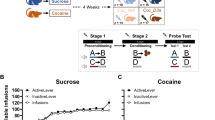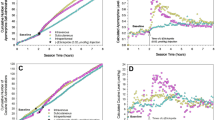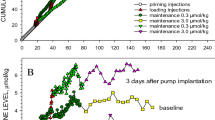Abstract
Previous studies employed a second-order schedule paradigm maintained by cocaine reinforcement to show that BP897, a dopamine D3 partial agonist, selectively modulated drug-seeking behavior. We investigated its effect on drug-seeking behavior induced by presentation of stimuli associated with and predictive of cocaine availability after a period of extinction and in the absence of any further cocaine. Male rats were trained to associate discriminative stimuli (SD) with the availability of intravenous (i.v.) 0.25 mg/0.1 ml/infusion cocaine (SD+) or no-reward (SD−) saline solution. Each infusion of cocaine or saline was followed by a response-cue signaling 20-s time-out (TO). After meeting the self-administration training criterion rats were placed on extinction conditions during which i.v. solutions and SDs were withheld. Every other 3 days on which rats met the extinction criterion, reinstatement tests were conducted, presenting the SD+ or SD− noncontingently together with a contingent presentation of cocaine- or saline-cues signaling 20-s TO. Regardless of the order of presentation or the nature of the stimuli (auditory or visual), cocaine-associated but not saline-associated stimuli reinstated responding on the previously active lever. Presentation of cocaine-associated stimuli induced lasting drug-seeking behavior for at least eight test sessions. BP897 (1.0 mg/kg i.p.) significantly attenuated this behavior. Since it has been reported that BP897 can interact with a panel of different receptors with high affinity, we evaluated the effects of 7-OH-DPAT, an agonist to D3 receptors, raclopride, a preferential antagonist to D2 receptors, and WAY 100,635, an antagonist at 5-HT1A receptors, on drug-seeking behavior. 7-OH-DPAT (0.1–3.0 mg/kg i.p.) had biphasic effects on reinstatement induced by the cocaine-associated cues, low dosages reducing and high dosages increasing the impact of cocaine-associated stimuli on rats' behavior. Raclopride (0.1, 0.3 mg/kg s.c.) completely prevented drug-seeking behavior induced by the reintroduction of cocaine-associated stimuli. WAY 100,635 (0.1–1.0 mg/kg s.c.) had no effect on this behavior. These results, while confirming that the partial agonist at the D3 receptors, BP897, might be a useful medication, also suggest a role of D2 receptors in cue-induced cocaine-seeking behavior.
Similar content being viewed by others
Log in or create a free account to read this content
Gain free access to this article, as well as selected content from this journal and more on nature.com
or
References
Alleweireldt AT, Weber SM, Neisewander JL (2001). Passive exposure to a contextual discriminative stimulus reinstates cocaine-seeking behavior in rats. Pharmacol Biochem Behav 69: 555–560.
Aujla H, Sokoloff P, Beninger RJ (2002). A dopamine D3 receptor partial agonist blocks the expression of conditioned activity. Neuroreport 13: 173–176.
Bouthenet ML, Souil E, Martres MP, Sokoloff P, Giros B, Schwartz JC (1991). Localization of dopamine D3 receptor mRNA in the rat brain using in situ hybridization histochemistry: comparison with dopamine D2 receptor mRNA. Brain Res 564: 203–219.
Caine SB, Koob GF (1994). Effects of dopamine D-1 and D-2 antagonists on cocaine self-administration under different schedules of reinforcement in the rat. J Pharmacol Exp Ther 270: 209–218.
Caine SB, Lintz R, Koob (1993). Intravenous drug self-administration techniques in animals. In: Sahgal EA (ed). Behavioral Neuroscience: A Practical Approach. Oxford IRL Press: Oxford. pp 117–143.
Caine SB, Negus SS, Mello NK, Bergman J (1999). Effects of dopamine D(1-like) and D(2-like) agonists in rats that self-administer cocaine. J Pharmacol Exp Ther 291: 353–360.
Camps M, Kelly PH, Palacios JM (1990). Autoradiographic loca-lization of dopamine D1 and D2 receptors in the brain of several mammalian species. J Neural Transm Gen Sect 80: 105–127.
Cervo L, Mocaer E, Bertaglia A, Samanin R (2000). Roles of 5-HT(1A) receptors in the dorsal raphe and dorsal hippocampus in anxiety assessed by the behavioral effects of 8-OH-DPAT and S 15535 in a modified Geller–Seifter conflict model. Neuropharmacology 39: 1037–1043.
Childress AR, McLellan AT, Ehrman R, O'Brien CP (1988). Classically conditioned responses in opioid and cocaine dependence: a role in relapse? NIDA Res Monogr 84: 25–43.
Childress AR, O'Brien CP (2000). Dopamine receptor partial agonists could address the duality of cocaine craving. Trends Pharmacol Sci 21: 6–9.
Ciccocioppo R, Sanna PP, Weiss F (2001). Cocaine-predictive stimulus induces drug-seeking behavior and neural activation in limbic brain regions after multiple months of abstinence: reversal by D(1) antagonists. Proc Natl Acad Sci USA 98: 1976–1981.
Cussac D, Newman-Tancredi A, Audinot V, Nicolas JP, BoutinQ1 JA, Gobert A et al (2000). The novel dopamine D3 receptor partial agonist, BP897, is a potent ligand at diverse adrenergic and serotonergic receptors. Soc Neurosci Abstr 26: 2154.
de Wit H, Stewart J (1981). Reinstatement of cocaine-reinforced responding in the rat. Psychopharmacology 75: 134–143.
Dekeyne A, Rivet JM, Gobert A, Millan MJ (2001). Generalization of serotonin (5-HT)1A agonists and the antipsychotics, clozapine, ziprasidone and S16924, but not haloperidol, to the discriminative stimuli elicited by PD128,907 and 7-OH-DPAT. Neuropharmacology 40: 899–910.
Diaz J, Pilon C, Le Foll B, Gros C, Triller A, Schwartz JC et al (2000). Dopamine D3 receptors expressed by all mesencephalic dopamine neurons. J Neurosci 20: 8677–8684.
Di Ciano P, Blaha CD, Phillips AG (1998). Conditioned changes in dopamine oxidation currents in the nucleus accumbens of rats by stimuli paired with self-administration or yoked-administration of d-amphetamine. Eur J Neurosci 10: 1121–1127.
Everitt BJ, Di Ciano P, Underwood R, Hagan JJ (2001). Attenuation of drug-seeking by a selective D3 dopamine receptor antagonist. Soc Neurosci Abstr 27: 1711.
Ehrman RN, Robbins SJ, Childress AR, O'Brien CP (1992). Conditioned responses to cocaine-related stimuli in cocaine abuse patients. Psychopharmacology (Berl) 107: 523–529.
Everitt BJ, Wolf ME (2002). Psychomotor stimulant addiction: a neural systems perspective. J Neurosci 22: 3312–3320.
Fletcher A, Forster EA, Bill DJ, Brown G, Cliffe IA, Hartley JE et al (1996). Electrophysiological, biochemical, neurohormonal and behavioural studies with WAY-100635, a potent, selective and silent 5-HT1A receptor antagonist. Behav Brain Res 73: 337–353.
Fontana DJ, Post RM, Pert A (1993). Conditioned increases in mesolimbic dopamine overflow by stimuli associated with cocaine. Brain Res 629: 31–39.
Fuchs RA, Tran-Nguyen LT, Specio SE, Groff RS, Neisewander JL (1998). Predictive validity of the extinction/reinstatement model of drug craving. Psychopharmacology 135: 151–160.
Fuchs RA, Tran-Nguyen LT, Weber SM, Khroyan TV, Neisewander JL (2002). Effects of 7-OH-DPAT on cocaine-seeking behavior and on re-establishment of cocaine self-administration. Pharmacol Biochem Behav 72: 623–632.
Gainetdinov RR, Sotnikova TD, Grekhova TV, Rayevsky KS (1996). In vivo evidence for preferential role of dopamine D3 receptor in the presynaptic regulation of dopamine release but not synthesis. Eur J Pharmacol 308: 261–269.
Gawin FH (1991). Cocaine addiction: psychology and neurophysiology. Science 251: 1580–1586.
Gawin FH, Kleber HD (1986). Abstinence symptomatology and psychiatric diagnosis in cocaine abusers. Clinical observations. Arch Gen Psychiatry 43: 107–113.
Gilbert DB, Millar J, Cooper SJ (1995). The putative dopamine D3 agonist, 7-OH-DPAT, reduces dopamine release in the nucleus accumbens and electrical self-stimulation to the ventral tegmentum. Brain Res 681: 1–7.
Hoyer D, Boddeke HW (1993). Partial agonists, full agonists, antagonists: dilemmas of definition. Trends Pharmacol Sci 14: 270–275.
Ito R, Dalley JW, Howes SR, Robbins TW, Everitt BJ (2000). Dissociation in conditioned dopamine release in the nucleus accumbens core and shell in response to cocaine cues and during cocaine-seeking behavior in rats. J Neurosci 20: 7489–7495.
Jaffe JH, Cascella NG, Kumor KM, Sherer MA (1989). Cocaine-induced cocaine craving. Psychopharmacology 97: 59–64.
Kiyatkin EA (1993). Cocaine enhances the changes in extracellular dopamine in nucleus accumbens associated with reinforcing stimuli: a high-speed chronoamperometric study in freely moving rats. Eur J Neurosci 5: 284–291.
Kuhar MJ, Pilotte NS (1996). Neurochemical changes in cocaine withdrawal. Trends Pharmacol Sci 17: 260–264.
Le Foll B, Frances H, Diaz J, Schwartz JC, Sokoloff P (2002). Role of the dopamine D3 receptor in reactivity to cocaine-associated cues in mice. Eur J Neurosci 15: 2016–2026.
Levant B (1997). The D3 dopamine receptor: neurobiology and potential clinical relevance. Pharmacol Rev 49: 231–252.
Levant B (1998). Differential distribution of D3 dopamine receptors in the brains of several mammalian species. Brain Res 800: 269–274.
Levant B, Bancroft GN, Selkirk CM (1996). In vivo occupancy of D2 dopamine receptors by 7-OH-DPAT. Synapse 24: 60–64.
Levesque D, Diaz J, Pilon C, Martres MP, Giros B, Souil E et al (1992). Identification, characterization, and localization of the dopamine D3 receptor in rat brain using 7-[3H]hydroxy-,-di–propyl-2-aminotetralin. Proc Natl Acad Sci USA 89: 8155–8159.
Malmberg A, Mikaels A, Mohell N (1998). Agonist and inverse agonist activity at the dopamine D3 receptor measured by guanosine 5′(gamma thio)triphosphate (S35) binding. J Pharmacol Exp Ther 285: 119–126.
Meil WM, See RE (1997). Lesions of the basolateral amygdala abolish the ability of drug associated cues to reinstate responding during withdrawal from self-administered cocaine. Behav Brain Res 87: 139–148.
Millan MJ, Girardon S, Monneyron S, Dekeyne A (2000). Discriminative stimulus properties of the dopamine D3 receptor agonists, PD128,907 and 7-OH-DPAT: a comparative characterization with novel ligands at D3 versus D2 receptors. Neuropharmacology 39: 586–598.
Mirenowicz J, Schultz W (1996). Preferential activation of midbrain dopamine neurons by appetitive rather than aversive stimuli. Nature 379: 449–451.
Murray AM, Ryoo HL, Gurevich E, Joyce JN (1994). Localization of dopamine D3 receptors to mesolimbic and D2 receptors to mesostriatal regions of human forebrain. Proc Natl Acad Sci USA 91: 11271–11275.
Newman-Tancredi A, Cussac D, Audinot V, Pasteau V, Gavaudan S, Millan MJ (1999). G protein activation by human dopamine D3 receptors in high-expressing Chinese hamster ovary cells: a guanosine-5′-O-(3-[35S]thio)-triphosphate binding and antibody study. Mol Pharmacol 55: 564–574.
Pilla M, Perachon S, Sautel F, Garrido F, Mann A, Wermuth CG et al (1999). Selective inhibition of cocaine-seeking behaviour by a partial dopamine D3 receptor agonist. Nature 400: 371–375.
Pulvirenti L, Koob GF (1994). Dopamine receptor agonists, partial agonists and psychostimulant addiction. Trends Pharmacol Sci 15: 374–379.
Reavill C, Taylor SG, Wood MD, Ashmeade T, Austin NE, Avenell KY et al (2000). Pharmacological actions of a novel, high-affinity, and selective human dopamine D(3) receptor antagonist, SB-277011-A. J Pharmacol Exp Ther 294: 1154–1165.
Richfield EK, Young AB, Penney JB (1987). Comparative distribution of dopamine D1 and D-2 receptors in the basal ganglia Q1of turtles, pigeons, rats, cats, and monkeys. J Comp Neurol 262: 446–463.
Rohsenow DJ, Niaura RS, Childress AR, Abrams DB, Monti PM (1990). Cue reactivity in addictive behaviors: theoretical and treatment implications. Int J Addict 25: 957–993.
Schenk S (2000). Effects of the serotonin 5-HT(2) antagonist, ritanserin, and the serotonin 5-HT(1A) antagonist, WAY 100635, on cocaine-seeking in rats. Pharmacol Biochem Behav 67: 363–369.
Self DW, Barnhart WJ, Lehman DA, Nestler EJ (1996). Opposite modulation of cocaine-seeking behavior by D1- and D2-like dopamine receptor agonists. Science 271: 1586–1589.
Sokoloff P, Giros B, Martres MP, Bouthenet ML, Schwartz JC (1990). Molecular cloning and characterization of a novel dopamine receptor (D3) as a target for neuroleptics. Nature 347: 146–151.
Stewart J (1983). Conditioned and unconditioned drug effects in relapse to opiate and stimulant drug self-adminstration. Prog Neuropsychopharmacol Biol Psychiatry 7: 591–597.
Weiss F, Maldonado-Vlaar CS, Parsons LH, Kerr TM, Smith DL, Ben-Shahar O (2000). Control of cocaine-seeking behavior by drug-associated stimuli in rats: effects on recovery of extinguished operant-responding and extracellular dopamine levels in amygdala and nucleus accumbens. Proc Natl Acad Sci USA 97: 4321–4326.
Weiss F, Martin-Fardon R, Ciccocioppo R, Kerr TM, Smith DL, Ben-Shahar O (2001). Enduring resistance to extinction of cocaine-seeking behavior induced by drug-related cues. Neuropsychopharmacology 25: 361–372.
Weissenborn R, Deroche V, Koob GF, Weiss F (1996). Effects of dopamine agonists and antagonists on cocaine-induced operant responding for a cocaine-associated stimulus. Psychopharmacology 126: 311–322.
Whitelaw RB, Markou A, Robbins TW, Everitt BJ (1996). Excitotoxic lesions of the basolateral amygdala impair the acquisition of cocaine-seeking behaviour under a second-order schedule of reinforcement. Psychopharmacology 127: 213–224.
Wicke K, Garcia-Ladona J (2001). The dopamine D3 receptor partial agonist, BP 897, is an antagonist at human dopamine D3 receptors and at rat somatodendritic dopamine D3 receptors. Eur J Pharmacol 424: 85–90.
Wood MD, Boyfield I, Nash DJ, Jewitt FR, Avenell KY, Riley GJ (2000). Evidence for antagonist activity of the dopamine D3 receptor partial agonist, BP 897, at human dopamine D3 receptor. Eur J Pharmacol 407: 47–51.
Acknowledgements
Fruitful discussions with Dr Friedbert Weiss, Department of Neuropharmacology, Scripps Insitute, La Jolla, CA, USA, and Professor Vincenzo Crunelli, School of Bioscience, Cardiff University, Cardiff, Wales, UK, are gratefully acknowledged.
Author information
Authors and Affiliations
Corresponding author
Additional information
This manuscript is dedicated to the memory of Dr Rosario Samanin.
Rights and permissions
About this article
Cite this article
Cervo, L., Carnovali, F., Stark, J. et al. Cocaine-Seeking Behavior in Response to Drug-Associated Stimuli in Rats: Involvement of D3 and D2 Dopamine Receptors. Neuropsychopharmacol 28, 1150–1159 (2003). https://doi.org/10.1038/sj.npp.1300169
Received:
Revised:
Accepted:
Published:
Issue date:
DOI: https://doi.org/10.1038/sj.npp.1300169
Keywords
This article is cited by
-
Effects of the monoamine stabilizer, (-)-OSU6162, on cocaine-induced locomotion and conditioned place preference in mice
Naunyn-Schmiedeberg's Archives of Pharmacology (2021)
-
Dopamine D1 Receptor Within Basolateral Amygdala Is Involved in Propofol Relapse Behavior Induced by Cues
Neurochemical Research (2018)
-
Effects of pramipexole on the acquisition of responding with opioid-conditioned reinforcement in the rat
Psychopharmacology (2015)
-
Cariprazine (RGH-188), a D3-preferring dopamine D3/D2 receptor partial agonist antipsychotic candidate demonstrates anti-abuse potential in rats
Psychopharmacology (2013)
-
Adenosine A2A Receptors in the Nucleus Accumbens Bi-Directionally Alter Cocaine Seeking in Rats
Neuropsychopharmacology (2012)



